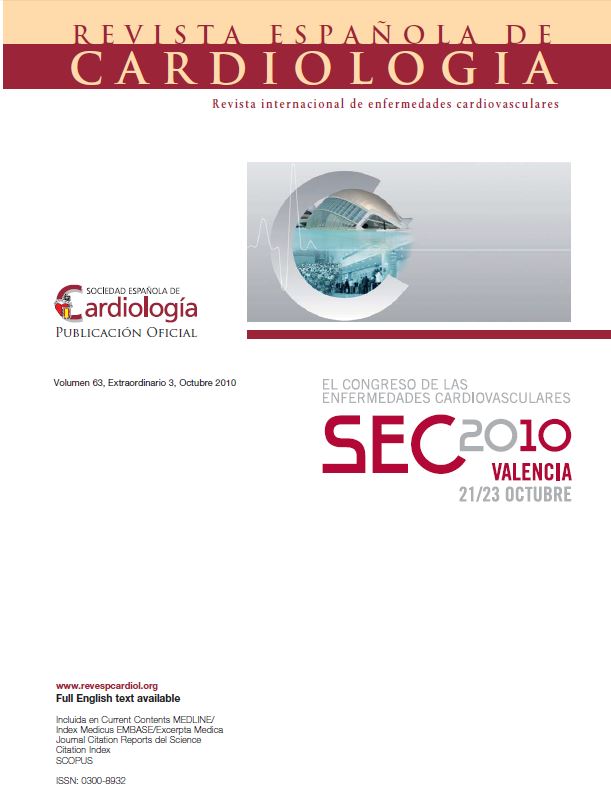SEC 2010 - El Congreso de las Enfermedades Cardiovasculares
4043. Riesgo cardiovascular
4043-2. Una nueva escala de riesgo cardiovascular para la población mediterránea de bajo riesgo: el proyecto ERICE
Introduction: The HeartScore does not consider people older than 70 or diabetes status. Development of a specific CVD score for the elderly including the diabetic status.
Methods and materials: 10-year follows up of a Spanish elderly cohort. Population-based random sample of citizens > 65 years from the census (n = 3,750). Baseline examination in 1994. CVD events classified by the ICD-9 (codes 401-448). Subjects with previous MI at baseline (prevalent) excluded. Diagnosis of Diabetes by WHO 1999 and hypertension by JNC-VII definition. The risk functions calculated using Cox proportional hazard model. Separate hazard functions for men and women.
Results: In 86.4 % of participants information on 10-year CVD mortality and morbidity was obtained. Independent CV risk factors were: age (RR 4.38, CI95 %: 1.84-10.46); male gender (RR 1.94; 1.32-2.86); diabetes (RR 2.31; 1.33-4.02); and hypertension (RR 2.78; 1.30-5.96). A negative interaction was found between age and hypertension. Smoking and total cholesterol were not significant variables in any of the different models tested. The absolute risk increased exponentially with age, both in men and women. Males consistently showed a two-fold risk than women for each risk category at all age-groups. The presence of diabetes, hypertension or both on the same individual, significantly increased the CVD 10-year risk. In males without diabetes and hypertension from 2 % to 27 %, but only from 12 % to 27 % when both were present. However, the contribution of hypertension and diabetes at oldest ages (> 85 years) to the CVD incremental risk was marginal, both in males and females in this age-group.
Conclusions: Age is the strongest predictor of 10-year CVD, both in males and females. Males had two-fold risk than women for all risk categories and age groups. Smoking and total-cholesterol were not significant risk factors for CVD in this elderly cohort. The EPICARDIAN Score is the first specific tool of CVD risk assessment in an elderly population.
Comunicaciones disponibles de "Riesgo cardiovascular "
- 4043-1. Duración del intervalo QT y mortalidad en el estudio NHANES III
- Yiyi Zhang, Wendy S. Post, Elena Blasco-Colmenares, Darshan Dalal, Gordon S. Tomaselli, Eliseo Guallar Castillón, Departamentos de Epidemiología y Medicina (Cardiología) del Johns Hopkins School of Public Health, Baltimore (Estados Unidos), Welch Center para Prevención Epidemiológica e Investigación Clínica del Johns Hopkins Medical Institutions, Baltimore (Estados Unidos) y Departamento de Epidemiología Cardiovascular y Genética de Poblaciones del Centro Nacional de Investigaciones Cardiovasculares (CNIC), Madrid.
- 4043-2. Una nueva escala de riesgo cardiovascular para la población mediterránea de bajo riesgo: el proyecto ERICE
- Rafael Gabriel Sánchez, Laura Lorenzo Carrascosa, Margarita Alonso Arroyo, Francisco Rodríguez Salvanés, Saturio Vega, Carmen Suárez Fernández, Javier Muñiz García, Hospital Universitario La Paz, Madrid, Complexo Hospitalario Universitario A Coruña, A Coruña y Hospital Universitario de la Princesa, Madrid.
- 4043-3. Diferencias de género en la asociación entre cadmio en sangre y orina y enfermedad arterial periférica en población adulta de Estados Unidos
- María Téllez Plaza, Ana Navas Acien, Ciprian M. Crainiceanu, A. Richey Sharret, Eliseo Guallar Castillón, Fundación Centro Nacional de Investigaciones Cardiovasculares Carlos III (CNIC), Madrid y Johns Hopkins School of Public Health, Baltimore (Estados Unidos).
- 4043-4. Factores poblacionales asociados a la insuficiencia cardiaca y la cardiopatía isquémica en España: papel de la hipertensión arterial
- Alberto Cordero Fort, Pilar Mazón Ramos, José Ramón González-Juanatey, Enric Galve Basilio, Iñaki Lekuona Goya, Juan Cosín Sales, Lorenzo Fácila Rubio, Vicente Bertomeu Martínez, Hospital Universitario San Juan, Alicante, Complexo Hospitalario Universitario de Santiago de Compostela, A Coruña y Hospital Provincial, Castellón.
- 4043-5. La escala de riesgo CHADS2 estratifica el riesgo cardiovascular en pacientes con fibrilación auricular bajo tratamiento anticoagulante oral
- Francisco Marín Ortuño, Vanessa Roldán Schilling, Begoña Muiña Juárez, Diana Hernández Romero, Eva Jover García, Mariano Valdés Chávarri, Vicente Vicente García, Gregory Y.H. Lip, Hospital Universitario Virgen de la Arrixaca, El Palmar (Murcia), Hospital Universitario José M. Morales Meseguer, Murcia y City Hospital, Birmingham (Reino Unido).
- 4043-6. Nuevos factores predisponentes para el desarrollo de endocarditis infecciosa. Cambios producidos a lo largo de 23 años
- Juan Carlos Castillo Domínguez, Miguel Puentes Chiachio, Manuel Anguita Sánchez, Marta Santisteban Sánchez de Puerta, María Luisa Peña Peña, José López Aguilera, José M. Arizón del Prado, José Suárez de Lezo, Hospital Universitario Reina Sofía, Córdoba.
Más comunicaciones de los autores
- Alonso Arroyo, Margarita
- Gabriel Sánchez, Rafael
- Lorenzo Carrascosa, Laura
- Muñiz García, Javier
- Rodríguez Salvanés, Francisco
- Suárez Fernández, Carmen
- Vega, Saturio
